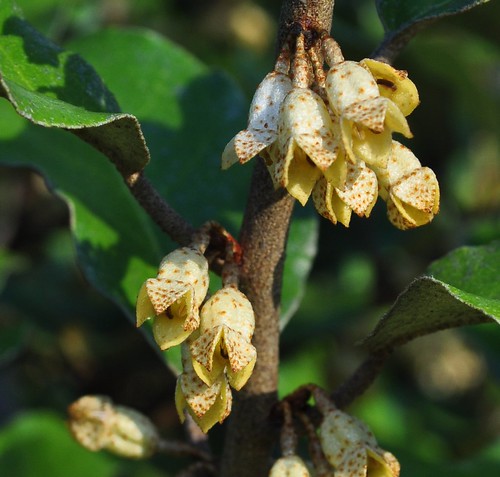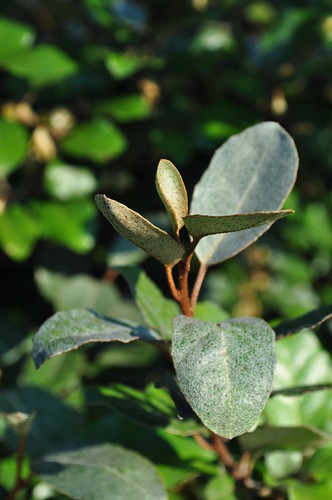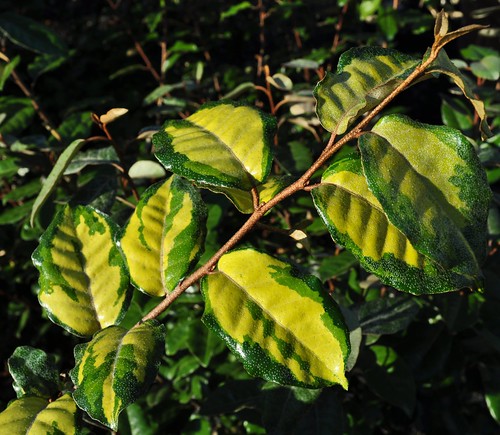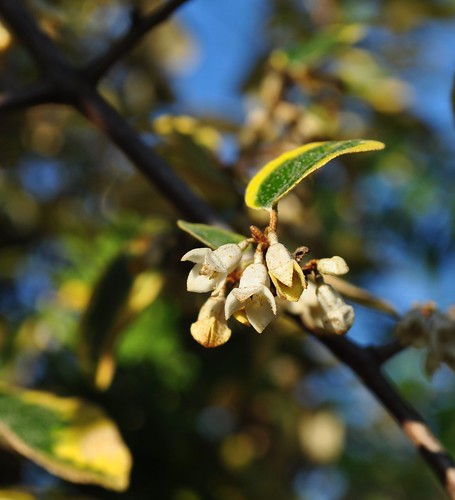There is a definite change in the air here in Tidewater. Not only is it cooler and less humid, but there is a change in the way things smell, I even caught whiff of wood smoke coming from someone's fire pit tonight. Frequently as you are strolling through the neighborhood or driving around town, you will come across a very sweet, sticky smell - the unmistakable odor of the Eleagnus bloom. It is hard to describe just how overly sweet this smell is, but it always triggers a memory for me. The smell reminds me of an Easter nearly 40 years ago when I ate way too many jelly beans, not those minuscule Jelly Bellies, but the larger old-fashioned variety made by Brachs. The flower of the Eleagnus smells like those jelly beans (in particular, the pink ones) that I nearly made myself sick with so long ago, and to this day causes me a twinge of nausea.
There are many species of Eleagnus, including several that are on invasive plant lists, but the most common varieties seen in this area, and the ones currently sweetening the air - are Eleagnus x ebbingei and E. pungens. Both of these evergreens grow extremely quick providing fast screening and hedges. They are also remarkably drought and salt tolerant making a great seashore plant. One of the several common names of this plant is Silverberry, and this must be a reference to its silvery foliage. There are also brown spots on the leaves and stems which are often mistakenly thought a fungus. Eleagnus is sometimes called Russian Olive, but one of my Russian customers indignantly said she had never seen any in the Motherland.
The flowers begin blooming in the fall (although they seem a little early to me this year) and can continue into late December. They produce fruits that swell and ripen in winter and resemble small brown olives that eventually turn red and provide needed late winter nourishment for some birds. If you were hungry enough, you could eat them too, in fact there are other species of Eleagnus grown specifically for the edible fruit. In this area they are planted more for their ease of growth and are often used by the highway departments for stabilizing embankments and for screening. There was once a locally famous patch in the median of Interstate 64 east of Williamsburg that had to be removed. It seemed the Cedar Waxwings could not resist the lure of the fermenting fruit and many impaired birds were unable to maneuver the gauntlet of busy traffic after their snack.
I prefer the Eleagnus x ebbingei because it lacks the thorns of E. pungens. There are also several interesting variegated cultivars like E. pungens 'Hosoba Fukurin'.
This is E. pungens 'Clemson Variegated'. I really like variegation when it appears tie-dyed.
The last variety is Eleagnus x ebbingei 'Gilt Edge' which we have planted at work in a very neglected spot where it thrives. I also planted some of these at the neighborhood dog park when it opened knowing how tough they are. However, nothing I planted including the 'Gilt Edge' survived the multiple daily "waterings" from the dogs.
October 3, 2009
Subscribe to:
Post Comments (Atom)











Good morning Les, I like the fragrance of the eleagnus. There was also a hedge along route 17 between York High and Yorktown Middle and driving to and fro with the kids I marveled at the fragrance without the appearance of blooms (at least none while driving 55 mph) That hedge was also removed. I have not seen the variegated ones, like the E. pungens 'Clemson Variegated' especially. Maybe I will find a place for a large hedge in SC...it is named Clemson!
ReplyDeleteI think it is early for these blooms too. My first memory of this fragrance wafting through the air was the day I 'graduated' my Master Gardener course and had to drive to get the girls from school. That was mid-November.
This is my all time go to shrub for almost anything that needs a quick screen or hedge! I have a large hedge in front of my home that shields the yard and house from the road and I tell you this cannot be beat! I only wish I could reach up high enough to snip a few errant twigs but it got so big so fast that is out the window now. I simply love this shrub-not the umbellata though. Many folks hear eleagnus and think Russian olive. I've also been noticing the scent this year and am not as fond of it as I have been in past years. Not sure the reasons but since I never eat jellybeans it can't be jellybeans:)
ReplyDeleteNever knew there were so many Eleagni (?).Only have the one with the fluffy coating on the variegated leaves and can't recall any flowers.
ReplyDeleteFunny how smells trigger memory.Mine is Coppertone suncream and Cape Cod's dunes.
That pungent smell in your neighbourhood must be like the fabric-softeners that overlay our village most days. People forget that it now comes highly concentrated (to save on water, so the manufacturers say ??) and put too much in. On non-laundry days I can smell the delicate perfume of the Abelia. You're right: The honeysuckle scent isn't anywhere near as strong as before. I hope my L.purpusii will perform this winter. First time since I planted a cutting from a friend.
Just be sure to give these plenty of room...they can easily turn into pruning nightmares!
ReplyDeleteI don't think I've ever actually smelled the fragrance of Eleagnus flowers. I've certainly seen it before, almost always as I'm driving by.
ReplyDeleteWhat a fascinating...and timely post! I've had some Eleagnus pop up along my fence row, not sure of the species (I was getting ready to type 'strains', as if they were microorganisms!) - and realized that I need to learn more about them. I like them - but need to better understand the invasive species compared to the ones that aren't so problematic (and are good for birds). The variegated ones are gorgeous - I haven't seen those before! Anyway, now that I know that the flowers smell like jelly beans, I'll have to pay attention to those that have invited themselves into my garden...
ReplyDeleteInteresting about your jelly bean episode and these trees, Les. We have some here, wildlings self seeded from birds from somewhere, growing under the tall pine trees where little else will grow. These may not get enough sun to flower and berry, but do have terrible thorns. There is a large hedge of them at the entrance to Mouse Creek nursery and the odor is quite pleasant. Never knew about the variegated ones, lovely. :-)
ReplyDeleteFrances
I wonder if this plant's smell was the smell we smelled in Pokipse (Poughkeepsie) this weekend. I thought we were smelling a cotton candy or sugar factory.
ReplyDeleteJanet,
ReplyDeleteI think it is so amazing how certain smells evoke memories, like your Master Gardener graduation and Eleagnus. Maybe since you will be moving closer to Clemson, 'Clemson Variegated' will be cheaper down there.
Tina,
I push this shrub too for people who need quick coverage that will not need a lot of care. If I feel that the customer likes neat, orderly straight lines, I don't even mention the plant.
Jo,
Wow, I am trying to get over the mental fragrance image of too many people using too much fabric softener. Fabric dryer sheets were recommended to us to control Loretta's lightening induced episodes. Apparently one is supposed to rub them on the dog's coat to quell static electricity build-up due to the storm. I think the sheets just overwhelm the poor dog's sense of smell distracting it from anything else.
Phillip,
Definately not a plant for small spaces.
Sweet Bay,
One odd thing I did not mention - they don't have the same intensity of fragrance every day. This may have something to do with temperature and/or humidity.
Pam,
Strains, cultivars, varieties whatever - I know what you mean. When I started working where I do now, we sold one of the invasive species, the deciduous E. angustifolia. I delivered one in full fruit to a customer who raised heirloom turkeys. She later told me the big birds stripped it of fruit in no time at all.
Frances,
Thank you! I have seen them pop up in the woods around work, so maybe the species we sell will one day be on the naughty list.
Georgia,
These plants are hardy into the lower reaches of zone 7, maybe 6 with protection. I would think it gets too cold for them there, but I could be wrong.
Les
Les,
ReplyDeleteMy first visit here, I'll be back too. Speaking of E. pungens back in 2004 I was the Monarch tagging guy at the Eastern Shore of VA and the huge hedge of it would get 100s of Monarchs on a good day. I could smell this hedge somedays a 1/2 mile away.
I remember the jelly bean smell--and so funny that you ate too many. I don't remember smelling this aroma but will be on the look out. Maybe I'm just not paying attention but it sounds like you would know if it was in the air.
ReplyDeleteIt's blooming in a friend's garden here in Nashville Les. It is huge, but the smell is very slight in her shady conditions. I have also caught a whiff of wood smoke on the breeze! gail
ReplyDeleteHey Les, eleagnus was the first thing we planted when we moved in our new house 3 years ago. We were going to put up a privacy fence but decided to go with this shrub instead. I planted about 30 of them along the edge of our property line on either side of the house for screening purposes. These are very tough plants and have some mean thorns on them. I've been stabbed quite a few times.
ReplyDeleteLove the fragrance they provide this time of year. We can smell them from almost any spot in the yard. In addition to the birds I've noticed that the bees like the sweet blooms as well. Definitely a good all around evergreen shrub.
Hi Les, I am a novice at gardening, located in central Florida and have been interested in the Elaeagnus Pungens
ReplyDelete'Maculata' or (Variegated Silverberry)for my garden. This plant seems to meet all my needs and I also enjoy the fact that it is variegated. To my dismay I have not been able to aquire this variety locally, nor have i been able to find it on line. Have any ideas?
Purple,
ReplyDeleteI am not sure why you can not find this plant. Maybe if you travel to the coast you may have better luck since they are often used in areas that get salt spray. Good luck in your quest.
Les
Thanks Les, I recently traveled the East Coast of Florida from Ft. Lauderdale to Daytona Beach via Rt. A1A stoppomg at nurseries along the way and no one seems to be familiar with this variety. :(
ReplyDelete